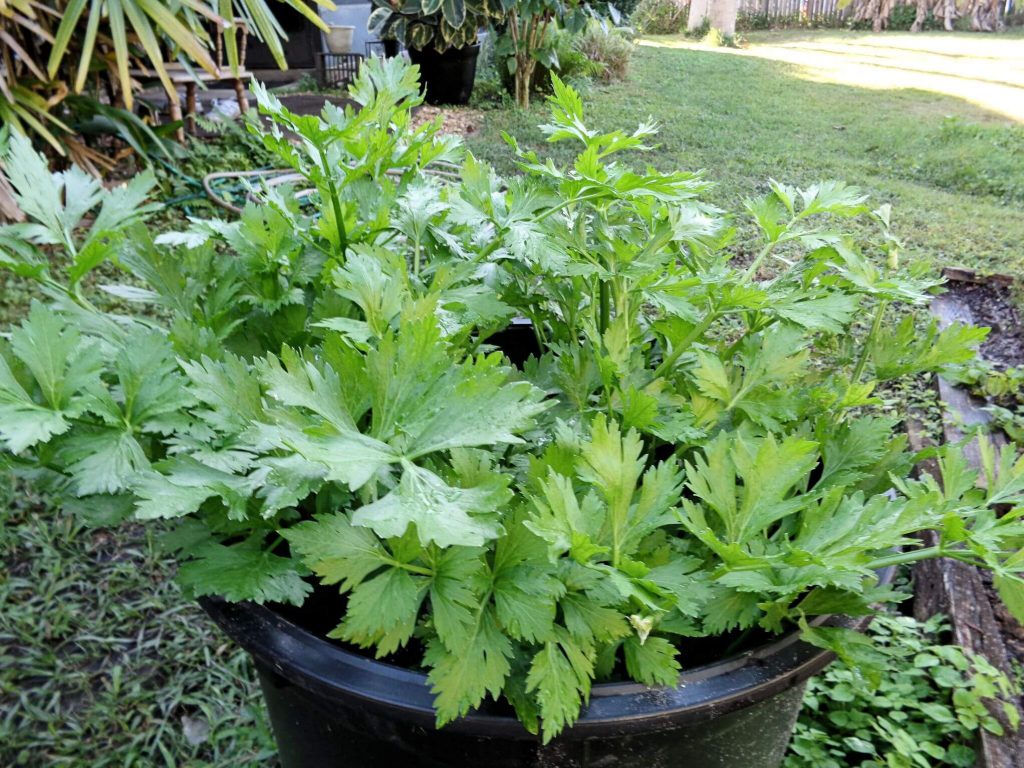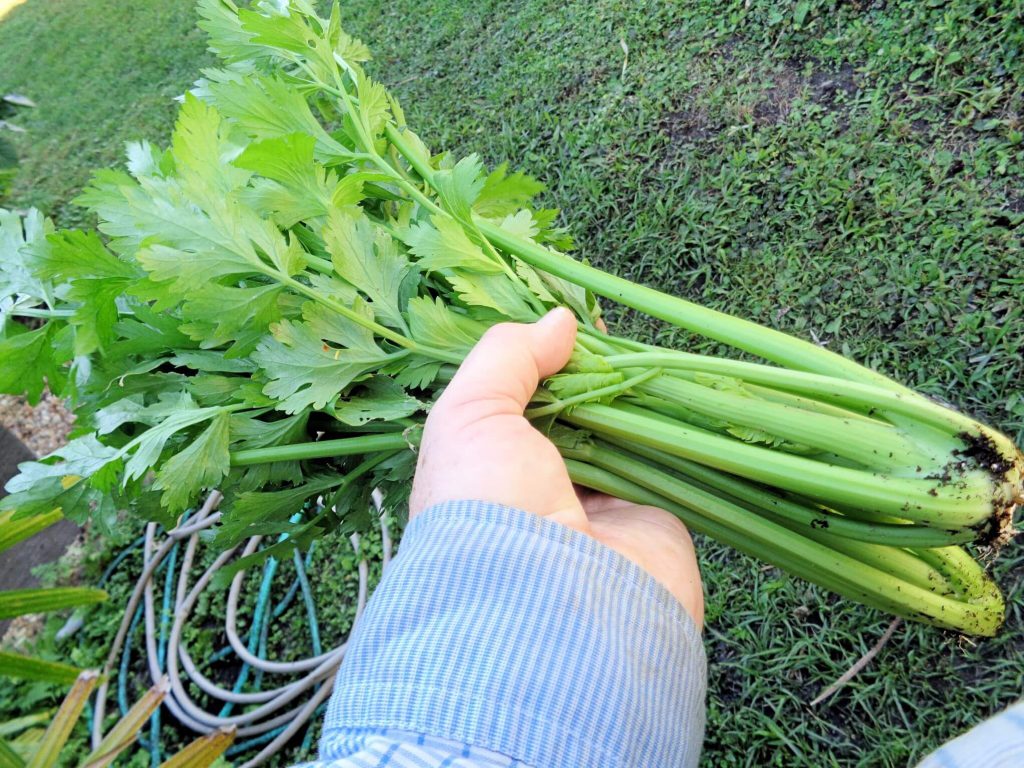By Ralph E. Mitchell
 I sometimes like to grow a plant just to see if I can succeed in the effort. While I tried growing celery several years ago with average success, I did manage to grow some better-than-average stalks this year. You can grow your own celery!
I sometimes like to grow a plant just to see if I can succeed in the effort. While I tried growing celery several years ago with average success, I did manage to grow some better-than-average stalks this year. You can grow your own celery!
Celery is related to carrots, fennel and parsley. If you allowed celery to go to seed and develop the umbrella-like flower cluster – typical of these biennials – you will see the carrot-like characteristics. Celery grows best in our cool season weather.
Accordingly, it is really getting late to try to grow celery now, and for best production you should put this vegetable in as early as October. Technically you can continue to plant this crop on through March, but it is starting to warm up. Success with celery includes sufficient growing time in relatively cool weather. Celery can take three months or more before it can be harvested. Commercially, most of Florida’s celery is grown in the southern part of the state as a winter crop.
As it can take some celery varieties one-hundred and twenty days from seed to harvestable plant, you need to get your hands on some started transplants as I did. In season, many garden centers are now offering well-developed transplants right along with the cabbage, cauliflower and broccoli seedlings. If possible, try to use ‘Utah’ cultivars which are recommended by our UF/IFAS Florida Vegetable Guide. I grew my celery in a plastic half whiskey barrel style pot filled with sterile potting medium. The five transplants in this large container were spaced about eight inches between plants. If you do plant your celery plants in the ground, space them six to twelve inches apart, in rows eighteen-inches apart. Celery appreciates moisture, so water as needed to keep the plants crisp and sweet.
I like my celery green and full-flavored, but you can “blanch” the plant if desired by slipping an empty milk carton over the whole young plant, or carefully tying the stalks together with string. The inner blanched stalks will become pale yellow and tend to be sweeter. You can harvest each stalk as needed, or take the whole plant carefully washing off any clinging soil.
My five celery plants were more than enough for my needs. I really like celery best as a soup seasoning, a stewed vegetable, and as salad garnish.
One other celery relative to try is celeriac. Celeriac is really grown for its knobby, turnip-like root which is celery-flavored. Grown just like celery, this cool-season crop is used in stews and soups.
Again , if you like to try something different, perhaps celery will be on your gardening menu this coming fall! For more information on all types of interesting vegetables that can be grown in your backyard, please call our Master Gardener volunteers on the Plant Lifeline on Mondays, Wednesdays and Fridays from 1 to 4 pm at 764-4340 for gardening help and insight into their role as an Extension volunteer. Just as a reminder, our new office is located at the North Charlotte Regional Park at 1120 O’Donnell Blvd, Port Charlotte FL 33953. Please take the Jenks Drive detour while construction is underway on O’Donnell. The Plant Lifeline is also now open at our new site! Our phone numbers and email addresses continue to remain the same. Don’t forget to visit our other County Plant Clinics in the area. Please check this link for a complete list of site locations, dates and times – https://sfyl.ifas.ufl.edu/media/sfylifasufledu/charlotte/docs/pdf/Plant-Clinics-Schedule1.pdf. Our Eastport Environmental Demonstration Garden is always open to the public outside the gate at 25550 Harbor View Road and will continue to be in operation and open to the public. Master Gardener volunteers tend this garden on Tuesday mornings from 8 to 10 am and are available for questions. Ralph E. Mitchell is the Director/Horticulture Agent for the UF/IFAS Charlotte County Extension Service. He can be reached at 941-764-4344 or ralph.mitchell@charlottecountyfl.gov.
, if you like to try something different, perhaps celery will be on your gardening menu this coming fall! For more information on all types of interesting vegetables that can be grown in your backyard, please call our Master Gardener volunteers on the Plant Lifeline on Mondays, Wednesdays and Fridays from 1 to 4 pm at 764-4340 for gardening help and insight into their role as an Extension volunteer. Just as a reminder, our new office is located at the North Charlotte Regional Park at 1120 O’Donnell Blvd, Port Charlotte FL 33953. Please take the Jenks Drive detour while construction is underway on O’Donnell. The Plant Lifeline is also now open at our new site! Our phone numbers and email addresses continue to remain the same. Don’t forget to visit our other County Plant Clinics in the area. Please check this link for a complete list of site locations, dates and times – https://sfyl.ifas.ufl.edu/media/sfylifasufledu/charlotte/docs/pdf/Plant-Clinics-Schedule1.pdf. Our Eastport Environmental Demonstration Garden is always open to the public outside the gate at 25550 Harbor View Road and will continue to be in operation and open to the public. Master Gardener volunteers tend this garden on Tuesday mornings from 8 to 10 am and are available for questions. Ralph E. Mitchell is the Director/Horticulture Agent for the UF/IFAS Charlotte County Extension Service. He can be reached at 941-764-4344 or ralph.mitchell@charlottecountyfl.gov.
Resources:
Brown, S. P., Treadwell, D., Stephens, J. M. & Webb, S. ( 2018) The Florida Vegetable Guide. The University of Florida Extension Service, IFAS.
Marantos, J. (2020) Growing your own celery is easier than you think. The Los Angeles Times.
Manning, J. & Brainard, D. (2020) Celery. Texas A&M AgriLife Extension.
Growing Celery. (2020) Utah State University Extension.
Stephens, J. (2018) Celeriac. The University of Florida Extension Service, IFAS.
Celery https://www.fdacs.gov/Consumer-Resources/Health-and-Safety/Living-Healthy-in-Florida/Healthy-Learning/All-About-Florida-Products/Celery
Salisbury, S. (2016) Duda Farms rules the celery world. The Palm Beach Post.
 0
0
